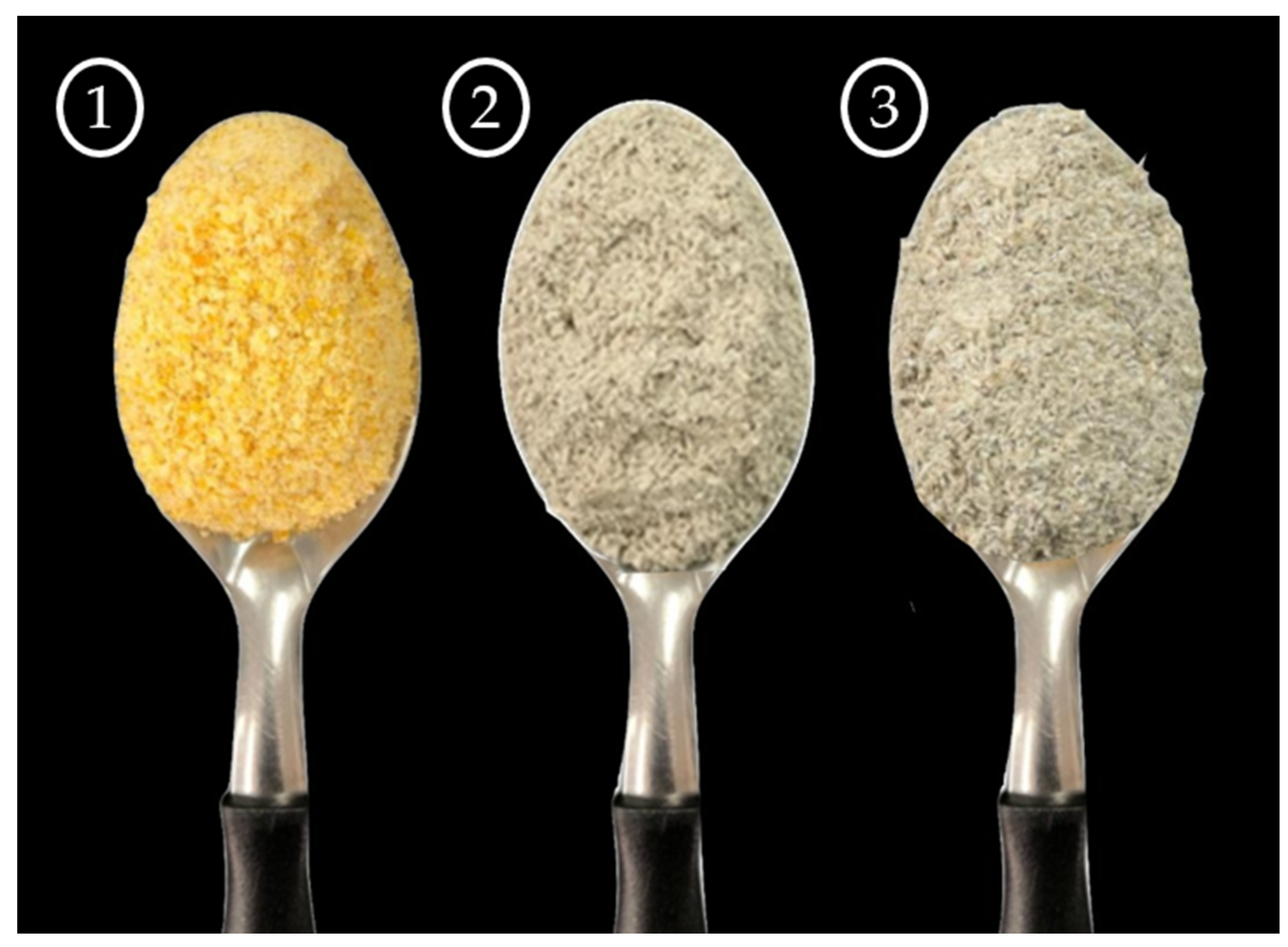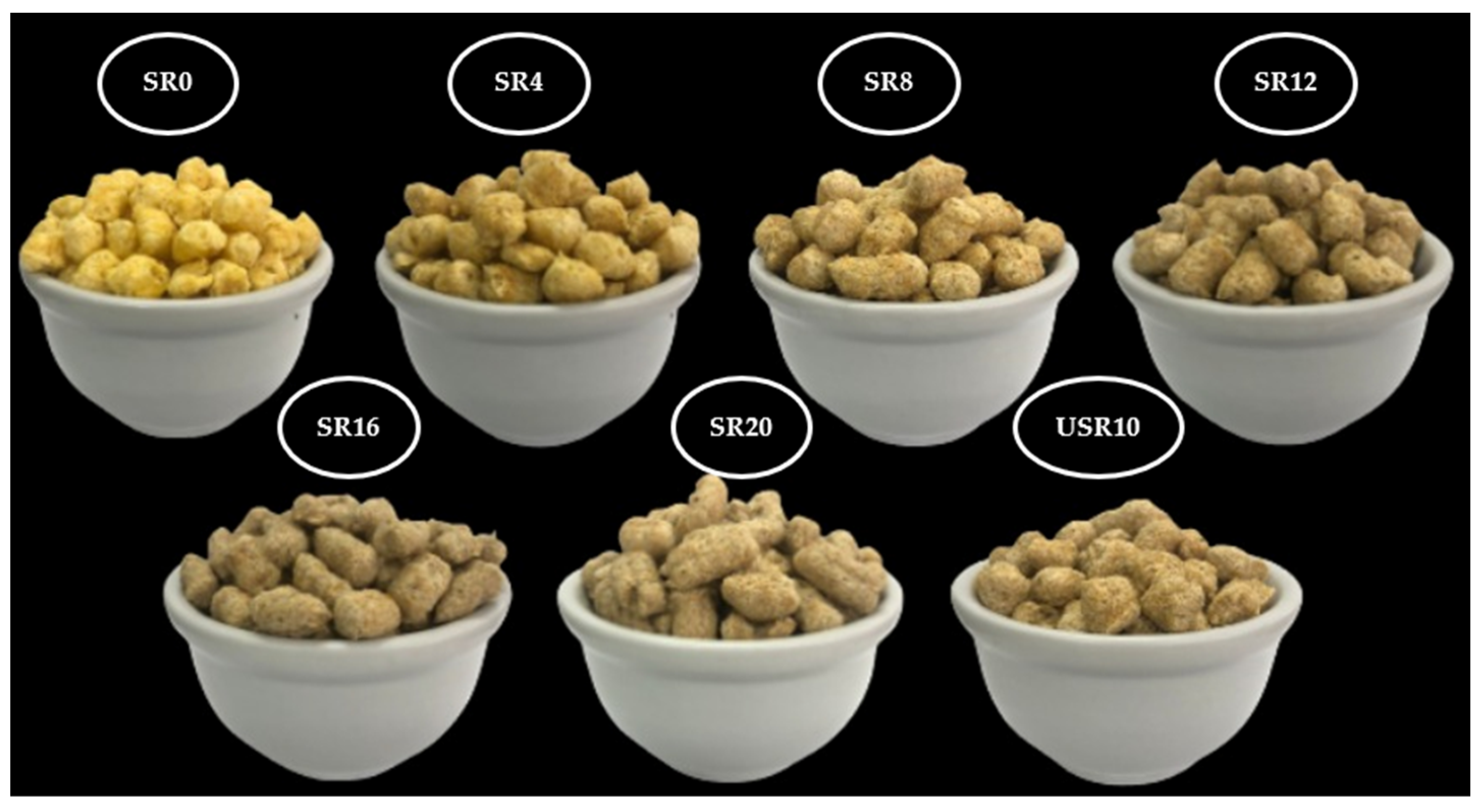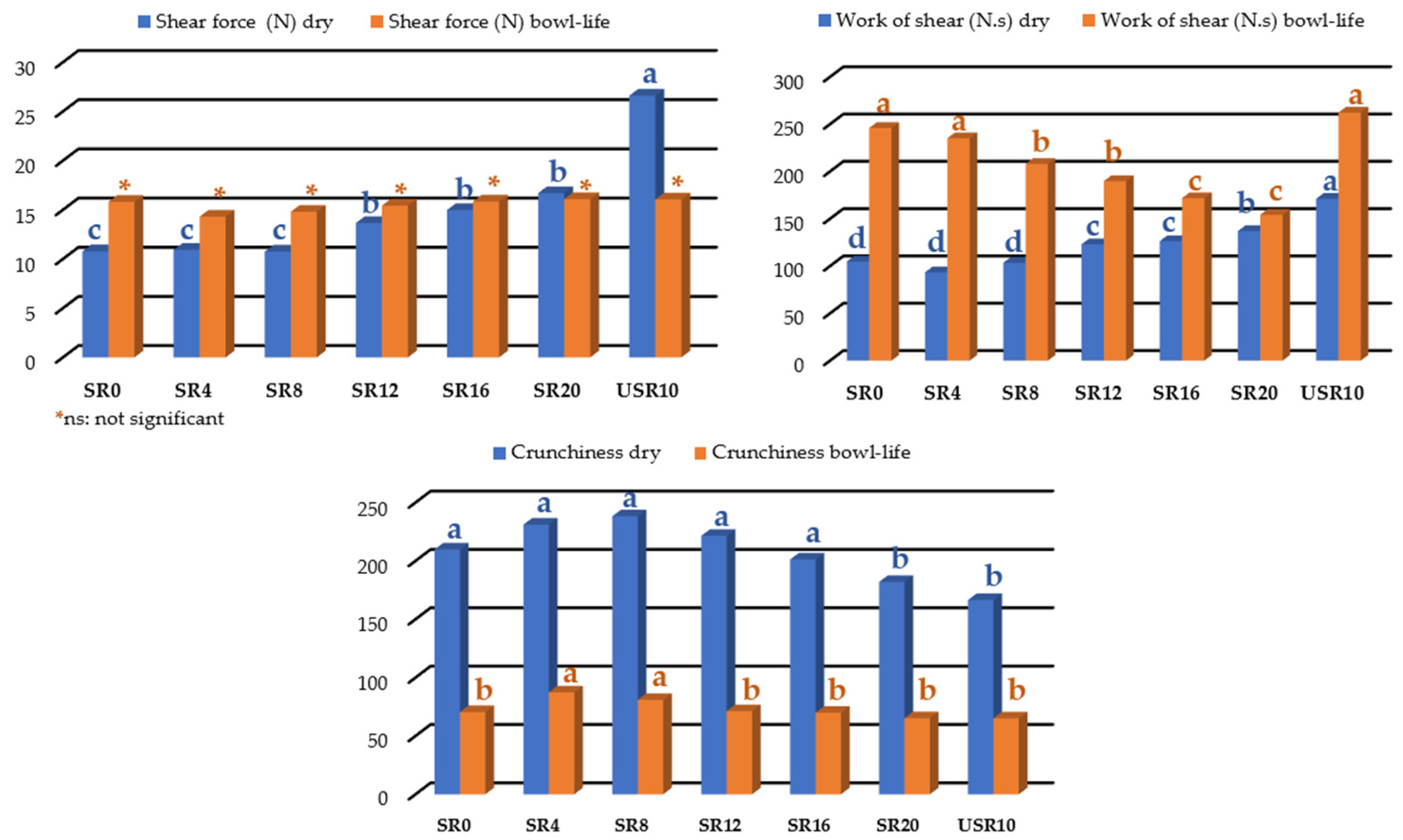New Breakfast Cereal Developed with Sprouted Whole Ryegrass Flour: Evaluation of Technological and Nutritional Parameters
Abstract
:1. Introduction
2. Materials and Methods
2.1. Materials
2.2. Methods
2.2.1. Ryegrass Sprouting
2.2.2. Obtaining the Whole Flours of Unsprouted Ryegrass, Sprouted Ryegrass, and Maize
2.2.3. Centesimal Composition of Whole Ryegrass and Maize Flour
2.2.4. Experimental Design, Test Preparation, and Thermoplastic Extrusion Processing to Produce Breakfast Cereals
2.2.5. Physico-Chemical Properties of Breakfast Cereals
Expansion Index, Bulk Density
Instrumental Color
Instrumental Texture of Dry Breakfast Cereals and after Immersion in Refrigerated Whole Milk (Bowl-Life)
Water Absorption Index and Water Solubility Index
γ-Aminobutiric Acid
Total Soluble Phenolic Compounds
2.2.6. Statistical Analysis
3. Results and Discussion
3.1. Nutritional, Technological, and Physicochemical Properties of Raw Material
3.2. Technological Properties of Breakfast Cereals
3.2.1. Radial Expansion Index and Bulk Density of Breakfast Cereal
3.2.2. Water Absorption Index and Water Solubility Index of Breakfast Cereals
3.2.3. Instrumental Color of Breakfast Cereals
3.2.4. Total Soluble Phenolic Compounds and γ-Aminobutyric Acid for Breakfast Cereals
3.2.5. Instrumental Texture for Breakfast Cereals
4. Conclusions
Author Contributions
Funding
Data Availability Statement
Acknowledgments
Conflicts of Interest
References
- Caporizzi, R.; Schönlechner, R.; D’amico, S.; Severini, C.; Derossi, A. Novel gluten-free breakfast cereals produced by extrusion cooking from rice and teff: Effects on microstructural, physical and nutritional properties. Foods 2023, 12, 609. [Google Scholar] [CrossRef] [PubMed]
- Lima, C.T.; Lima, N.G.; Rodrigues, S.M.; Schmiele, M. Enteropatias e perspectivas de um mundo sem glúten como alternativa: Uma revisão. In Proceedings of the I SICITAL—Simpósio de Ciência e Tecnologia de Alimentos, Diamantina, Brazil, 5–7 July 2022. [Google Scholar]
- Paucar-Menacho, L.M.; Castillo-Martínez, W.E.; Simpalo-Lopez, W.D.; Verona-Ruiz, A.L.; Lavado-Cruz, A.A.; Martínez-Villuenga, C.; Peñas, E.; Frias, J.; Schmiele, M. Performance of thermoplastic extrusion, germination, fermentation, and hydrolysis techniques on phenolic compounds in cereals and pseudocereals. Foods 2022, 11, 1957. [Google Scholar] [CrossRef] [PubMed]
- Mittelmann, A. Azevém BRS Integração. Embrapa Gado Leite 2017, 1, 39–41. [Google Scholar]
- Lemmens, E.; Montori, A.V.; Pangand, J.; Heirbaut, P.; Ritala, A.; Karlen, Y.; Delcour, J.A. Impact of cereal seed sprouting on its nutritional and technological properties: A critical review. Compr. Rev. Food Sci. Food Saf. 2019, 18, 305–328. [Google Scholar] [CrossRef] [PubMed]
- Carvalho, H.J.M.; Lima, C.T.; Leoro, M.G.V.; Schmiele, M. Sprouted sorghum impacts the grain radicle development and carbohydrates and protein levels in water-soluble extracts. In Proceedings of the V Congreso Internacional en Investigación e Innovación en Ingeniería, Ciencia y Tecnología de los Alimentos—IICTA, Manizales, Colombia, 7–9 October 2022. [Google Scholar]
- Bakhshy, E.; Zarinkamar, F.; Nazari, M. Structural and quantitative changes of starch in seed of Trigonella persica during germination. Int. J. Biol. Macromol. 2020, 164, 1284–1293. [Google Scholar] [CrossRef]
- Lima, C.T.; Santos, T.M.; Leite, I.A.; Gomes, L.R.; Meza, S.L.R.; Schmiele, M. Ryegrass as a novel source of food protein. In Proceedings of the IX International Conference on Food Proteins and Colloids (CIPCA 2023), Rio de Janeiro, Brazil, 9–11 May 2023. [Google Scholar]
- Srichuwong, S.; Curti, D.; Austin, S.; Kimg, R.; Lamothe, L.; Gloria-Hernandez, H. Physicochemical properties and starch digestibility of whole grain sorghums, millet, quinoa and amaranth flours, as affected by starch and non-starch constituents. Food Chem. 2017, 233, 1–10. [Google Scholar] [CrossRef]
- Xia, Q. Investigating the influence of selected texture-improved pretreatment techniques on storage stability of wholegrain brown rice: Involvement of processing-induced mineral changes with lipid degradation. Food Res. Int. 2017, 99, 510–521. [Google Scholar] [CrossRef]
- Paucar-Menacho, L.M.; Schmiele, M.; Lavado-Cruz, A.A.; Verona-Ruiz, A.L.; Mollá, C.; Peñas, E.; Frias, J.; Simpalo-Lopez, W.D.; Castillo-Martínez, W.E.; Martínez-Villuenga, C. Andean sprouted pseudocereals to produce healthier extrudates: Impact in nutritional and physicochemical properties. Foods 2022, 11, 3259. [Google Scholar] [CrossRef]
- Xiang, Z.; Deng, J.; Yang, K.; Zhu, Y.; Xia, C.; Chen, J.; Liu, T. Effect of processing on the release of phenolic compounds and antioxidant activity during in vitro digestion of hulless barley. Arab. J. Chem. 2021, 14, 103447. [Google Scholar] [CrossRef]
- Meza, S.L.R.; Sinnecker, P.; Schmiele, M.; Massaretto, I.L.; Chang, Y.K.; Marquez, U.M.L. Production of innovative gluten-free breakfast cereals based on red black rice by extrusion processing technology. J. Food Sci. Technol. 2019, 56, 4855–4866. [Google Scholar] [CrossRef]
- AACCI. Approved Methods of AACCI, 11th ed.; Methods 46-13.01, 30-25.01, and 08-01.01; The American Association of Cereal Chemists International: St. Paul, MN, USA, 2010. [Google Scholar]
- AOAC. Approved Methods of Analysis of AOAC International, 21st ed.; Methods 982.14 and 978.10; The Association of Official Analysis AOAC International: Gaithersburg, MD, USA, 2019. [Google Scholar]
- Oliveira, L.C.; Schmiele, M.; Steel, C.J. Development of whole grain wheat flour extruded cereal and process impacts on color, expansion, and dry and bowl-life texture. LWT—Food Sci. Technol. 2017, 75, 261–270. [Google Scholar] [CrossRef]
- Schmiele, M.; Jaekel, L.Z.; Ishida, P.M.G.; Chang, Y.K.; Steel, C.J. Gluten-free pasta with high protein content obtained by conventional processing. Ciênc. Rural 2013, 43, 908–914. [Google Scholar] [CrossRef]
- Genčić, M.S.; Stojanović, N.M.; Mladenović, M.Z.; Radulović, N.S. An HPLC-based assay for improved measurement of glutamate decarboxylase inhibition/activation. Neurochem. Int. 2022, 161, 105433. [Google Scholar] [CrossRef] [PubMed]
- Lima, C.T.; Santos, T.M.; Silva, L.E.P.; Leite, I.A.; Vendruscolo, R.G.; Neves, N.A.; Meza, S.L.R.; Schmiele, M. Optimization of extracting solution of total soluble phenolic compounds from ryegrass using white technology assisted by low-frequency ultrasound. In Proceedings of the XV Latin American Symposium on Food Science and Nutrition—15 SLACAN—The Food and Nutrition Science Revolution: Feeding the World Sustainably, Campinas, Brazil, 12–14 November 2023. [Google Scholar]
- Shewry, P.R.; Koksel, H.; Taylor, J.J. ICC Handbook of 21st Century Cereal Science and Technology, 1st ed.; Elsevier Science: Cambridge, MA, USA, 2023; 400p. [Google Scholar]
- El Sohaimy, S.A.; Mohamed, S.E.; Shehata, M.G.; Mehany, T.; Zaitoun, M.A. Compositional analysis and functional characteristics of quinoa flour. Annu. Res. Rev. Biol. 2018, 22, 1–11. [Google Scholar] [CrossRef]
- Spotti, M.J.; Campanella, O.H. Functional modifications by physical treatments of dietary fibers used in food formulations. Curr. Opin. Food Sci. 2017, 15, 70–78. [Google Scholar] [CrossRef]
- Dalbhagat, C.G.; Mahato, D.K.; Mishra, H.N. Effect of extrusion processing on physicochemical, functional and nutritional characteristics of rice and rice-based products: A review. Trends Food Sci. Technol. 2019, 85, 226–240. [Google Scholar] [CrossRef]
- Barros, S.K.A.; Souza, A.R.M.; Silva, F.S.; Pires, C.R.F.; Damiani, C.; Silveira, M.F.A.; Silva, C.R.E. Preparation of fresh gluten free pasta enriched with açaí waste flour (Euterpe oleracea Mart.) and bacaba (Oenocarpus bacaba Mart.). Res. Soc. Dev. 2021, 10, e1810613722. [Google Scholar] [CrossRef]
- Osório, C.; Machado, S.; Peixoto, J.; Bessada, S.; Pimentel, F.B.; Alves, R.C.; Oliveira, M.B.P.P. Pigments content (chlorophylls, fucoxanthin and phycobiliproteins) of different commercial dried algae. Separations 2020, 7, 33. [Google Scholar] [CrossRef]
- Silva, L.E.P.; Rodrigues, S.M.; Leoro, M.G.V.; Neves, N.A.; Schmiele, M. Prospecção da radiação por micro-ondas e da liofilização na elaboração e características tecnológicas e nutricionais da farinha de palma. In Proceedings of the I SICITAL—Simpósio de Ciência e Tecnologia de Alimentos, Diamantina, Brazil, 5–7 July 2022. [Google Scholar]
- Hitayezu, R.; Baakdah, M.M.; Kinnin, J.; Henderson, K.; Tsopmo, A. Antioxidant activity, avenanthramide and phenolic acid contents of oat milling fractions. J. Cereal Sci. 2015, 63, 35–40. [Google Scholar] [CrossRef]
- Kasote, D.; Tiozon, R.N.J.; Sartagoda, K.J.D.; Itagi, H.; Roy, P.; Kohili, A.; Regina, A.; Sreenivasulu, N. Food processing technologies to develop functional foods with enriched bioactive phenolic compounds in cereals. Front. Plant Sci. 2021, 12, 771276. [Google Scholar] [CrossRef]
- Reicgard, C.; Welton, T. Solvents and Solvent Effects in Organic Chemistry, 4st ed.; Jhon Wiley & Sons: Hoboken, NJ, USA, 2011; 718p. [Google Scholar]
- Kagan, I.A.; Goodman, J.P.; Seman, D.H.; Lawrence, L.M.; Smith, S.R. Effects of harvest date, sampling tie, and cultivar on total phenolic concentrations, water-soluble carbohydrate concentrations, and phenolic profiles of selected cool-season grasses in central Kentucky. J. Equine Vet. Sci. 2019, 79, 86–93. [Google Scholar] [CrossRef] [PubMed]
- Hashimoto, J.M.; Schmiele, M.; Nabeshima, E.H. Modelling to obtain expanded cowpea products in a twin screw extruder. Braz. J. Food Technol. 2021, 24, 11120. [Google Scholar] [CrossRef]
- Menis-Henrique, M.E.C.; Scarton, M.; Piran, M.V.F.; Clerici, M.T.P.S. Cereal fiber: Extrusion modifications for food industry. Curr. Opin. Food Sci. 2020, 33, 141–148. [Google Scholar] [CrossRef]
- Pereira, A.M.; Schmiele, M.; Souza, E.J.D.; Ávila, B.P.; Ramos, A.H.; Zavareze, E.R.; Gularte, M.A. Extrudate gluten-free breakfast cereals frow rice and corn flours with different amylose content: Technological and sensory properties. Food Sci. Technol. 2021, 56, 4182–4190. [Google Scholar]
- Andressa, I.; Nascimento, G.K.S.; Santos, T.M.; Oliveira, J.R.; Benassi, V.M.; Schmiele, M. Physicochemical changes induced by the sprouting process of purple pericap corn kernels. Braz. J. Dev. 2023, 9, 8051–8070. [Google Scholar] [CrossRef]
- Liang, M.H.; He, Y.J.; Liu, D.M.; Jiang, J.G. Regulation of carotenoid degradation and production of apocarotenoids in natural and engineered organisms. Crit. Rev. Biotechnol. 2021, 41, 513–534. [Google Scholar] [CrossRef]
- Los, F.G.B.; Zielinski, A.A.F.; Wojeicchowski, J.P.; Nogueira, A.; Demiate, I.M. Beans (Phaseolus vulgaris L.): Whole seeds with complex chemical composition. Curr. Opin. Food Sci. 2018, 19, 63–71. [Google Scholar] [CrossRef]
- Bešlo, D.; Došlić, G.; Agić, D.; Rastija, V.; Šperanda, M.; Gantner, V.; Lučić, B. Polyphenols in ruminant nutrition and their effects on reproduction. Antioxidants 2022, 11, 970. [Google Scholar] [CrossRef]
- Kagan, I.A. Soluble phenolic compounds of perennial ryegrass (Lolium perenne L.): Potential effects on animal performance, and challenges in determining profiles and concentrations. Anim. Feed Sci. Technol. 2021, 277, 114960. [Google Scholar] [CrossRef]
- Cao, M.; Fraser, K.; Jones, C.; Stewart, A.; Lyons, T.; Faville, M.; Barrett, B. Untargeted metabotyping Lolium perenne reveals population-level variation in plant flavonoids and alkaloids. Front. Plant Sci. 2017, 8, 133. [Google Scholar] [CrossRef]
- Fariaszewska, A.; Aper, J.; Van Huylenbroeck, J.; De Swaef, T.; Baert, J.; Pecio, Ł. Physiological and biochemical responses of forage grass varieties to mild drought stress under field conditions. Int. J. Plant Prod. 2020, 14, 335–353. [Google Scholar] [CrossRef]

 whole maize flour;
whole maize flour;  whole sprouted ryegrass flour; and
whole sprouted ryegrass flour; and  whole unsprouted ryegrass flour.
whole unsprouted ryegrass flour.
 whole maize flour;
whole maize flour;  whole sprouted ryegrass flour; and
whole sprouted ryegrass flour; and  whole unsprouted ryegrass flour.
whole unsprouted ryegrass flour.


| Component | Maize Flour | Sprouted Ryegrass | Unsprouted Ryegrass |
|---|---|---|---|
| Proteins | 7.03 ± 0.50 | 13.12 ± 0.16 | 13.11 ± 0.37 |
| Ether extract | 6.27 ± 0.05 | 2.70 ± 0.10 | 2.15 ± 0.18 |
| Ashes | 1.51 ± 0.68 | 5.09 ± 0.02 | 5.78 ± 0.01 |
| Digestible carbohydrates (starch and sugars) | 80.19 ± 0.64 | 65.17 ± 0.56 | 63.69 ± 0.43 |
| Total dietary fibers * | 5.00 ± 0.87 # | 13.92 ± 0.77 # | 15.27 ± 0.35 # |
| Parameters | Maize Flour | Sprouted Ryegrass | Unsprouted Ryegrass | |
|---|---|---|---|---|
| Water absorption index (g of gel·g−1 of sample, d.b.) | 2.75 ± 0.01 c | 3.82 ± 0.02 a | 3.48 ± 0.17 b | |
| Water solubility index (%, d.b.) | 5.31 ± 0.07 c | 11.72 ± 0.19 a | 6.80 ± 0.21 b | |
| Instrumental color | L* | 77.37 ± 0.10 a | 67.60 ± 0.04 c | 68.75 ± 0.04 b |
| a* | 7.28 ± 0.01 a | 2.72 ± 0.01 b | 2.57 ± 0.01 c | |
| b* | 39.74 ± 0.05 a | 14.75 ± 0.01 b | 14.43 ± 0.02 c | |
| γ-aminobutic acid (mg·100 g−1, d.b.) | 4.37 ± 0.02 b | 40.83 ± 3.78 a | 6.07 ± 0.04 b | |
| TSPC (mg GAE·100 g−1, d.b.) | 537.19 ± 31.48 c | 1002.58 ± 37.67 a | 841.46 ± 14.56 b | |
| Trials | Radial Expansion Index | Bulk Density (g·cm−3) | Water Absorption Index (g of gel/g of Sample, d.b.) | Water Solubility Index (%, d.b.) |
|---|---|---|---|---|
| SR0 | 1.93 ± 0.15 d | 0.18 ± 0.03 a | 7.71 ± 0.02 a | 25.68 ± 1.05 b |
| SR4 | 2.36 ± 0.13 a | 0.13 ± 0.02 c | 7.31 ± 0.14 b | 25.28 ± 1.95 b |
| SR8 | 2.30 ± 0.10 b | 0.13 ± 0.01 c | 7.59 ± 0.30 a | 24.48 ± 0.75 b |
| SR12 | 2.05 ± 0.08 b | 0.15 ± 0.02 b | 7.42 ± 0.03 b | 30.47 ± 1.50 a |
| SR16 | 2.03 ± 0.09 c | 0.15 ± 0.01 b | 7.36 ± 0.05 b | 22.96 ± 0.77 b |
| SR20 | 2.18 ± 0.08 c | 0.14 ± 0.01 c | 7.26 ± 0.07 b | 27.63 ± 1.15 a |
| USR10 | 2.50 ± 0.09 a | 0.15 ± 0.01 b | 7.60 ± 0.09 a | 22.18 ± 1.22 b |
| p-value | <0.001 | <0.001 | 0.038 | <0.001 |
| Trials | L* | a* | b* | ΔE |
|---|---|---|---|---|
| SR0 | 60.88 ± 0.28 a | 7.11 ± 0.11 a | 39.73 ± 0.22 a | - |
| SR4 | 54.26 ± 1.42 b | 7.06 ± 0.14 a | 34.96 ± 0.39 b | 8.12 ± 1.34 b |
| SR8 | 51.79 ± 1.25 c | 6.60 ± 0.14 b | 30.66 ± 0.61 c | 12.80 ± 1.32 b |
| SR12 | 50.44 ± 0.53 c | 5.80 ± 0.05 d | 27.40 ± 0.39 d | 16.15 ± 0.61 a |
| SR16 | 50.67 ± 0.37 c | 5.86 ± 0.06 d | 25.77 ± 0.21 e | 17.29 ± 0.22 b |
| SR20 | 50.29 ± 0.48 c | 5.46 ± 0.10 e | 24.13 ± 0.11 f | 18.88 ± 0.30 a |
| USR10 | 50.69 ± 0.70 c | 6.19 ± 0.20 c | 27.26 ± 0.30 d | 16.09 ± 0.38 d |
| p-value | <0.001 | <0.001 | <0.001 | <0.001 |
| Trials | Total Soluble Phenolic Compounds (mg GAE·100 g−1) | γ-Aminobutyric Acid (mg·100 g) |
|---|---|---|
| SR0 | 372.19 ± 28.04 f | 3.50 ± 0.10 e |
| SR4 | 485.96 ± 17.31 e | 7.96 ± 0.55 c |
| SR8 | 535.52 ± 44.56 d | 8.48 ± 0.71 c |
| SR12 | 586.37 ± 45.82 c | 8.64 ± 0.41 c |
| SR16 | 644.52 ± 34.75 b | 11.70 ± 0.60 b |
| SR20 | 699.36 ± 39.92 a | 14.52 ± 0.97 a |
| USR10 | 548.38 ± 30.18 d | 6.55 ± 0.20 d |
| p-value | <0.001 | <0.001 |
Disclaimer/Publisher’s Note: The statements, opinions and data contained in all publications are solely those of the individual author(s) and contributor(s) and not of MDPI and/or the editor(s). MDPI and/or the editor(s) disclaim responsibility for any injury to people or property resulting from any ideas, methods, instructions or products referred to in the content. |
© 2023 by the authors. Licensee MDPI, Basel, Switzerland. This article is an open access article distributed under the terms and conditions of the Creative Commons Attribution (CC BY) license (https://creativecommons.org/licenses/by/4.0/).
Share and Cite
Lima, C.T.; Santos, T.M.d.; Neves, N.d.A.; Lavado-Cruz, A.; Paucar-Menacho, L.M.; Clerici, M.T.P.S.; Meza, S.L.R.; Schmiele, M. New Breakfast Cereal Developed with Sprouted Whole Ryegrass Flour: Evaluation of Technological and Nutritional Parameters. Foods 2023, 12, 3902. https://doi.org/10.3390/foods12213902
Lima CT, Santos TMd, Neves NdA, Lavado-Cruz A, Paucar-Menacho LM, Clerici MTPS, Meza SLR, Schmiele M. New Breakfast Cereal Developed with Sprouted Whole Ryegrass Flour: Evaluation of Technological and Nutritional Parameters. Foods. 2023; 12(21):3902. https://doi.org/10.3390/foods12213902
Chicago/Turabian StyleLima, Cristiane Teles, Tatiane Monteiro dos Santos, Nathália de Andrade Neves, Alicia Lavado-Cruz, Luz Maria Paucar-Menacho, Maria Teresa Pedrosa Silva Clerici, Sílvia Letícia Rivero Meza, and Marcio Schmiele. 2023. "New Breakfast Cereal Developed with Sprouted Whole Ryegrass Flour: Evaluation of Technological and Nutritional Parameters" Foods 12, no. 21: 3902. https://doi.org/10.3390/foods12213902







